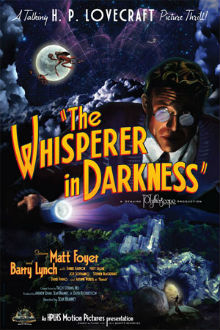The Whisperer in Darkness (film)
| The Whisperer in Darkness | |
|---|---|

Film poster
|
|
| Directed by | Sean Branney |
| Produced by | Sean Branney Andrew Leman David Robertson |
| Written by | Sean Branney Andrew Leman |
| Music by | Troy Sterling Nies |
| Edited by | David Robertson |
| Distributed by | H. P. Lovecraft Historical Society |
|
Release date
|
|
|
Running time
|
104 minutes |
| Country | United States |
| Language | English |
The Whisperer in Darkness is a 2011 independent film based on the H. P. Lovecraft short story of the same name, directed and produced by Sean Branney, Andrew Leman, and David Robertson and distributed by the H.P. Lovecraft Historical Society. It was shot using Mythoscope, a blend of vintage and modern filming techniques intended to produce the look of a 1930s-era film. According to the film's website, the filmmakers intended to capture the look of "classic horror films of the 1930s like Dracula, Frankenstein and King Kong".
For the first two acts, the plot follows the short story. In the third act, the protagonist, Wilmarth, uncovers an attempt by cultists to open a gateway between Yuggoth and Earth. He foils the plot with the help of Hannah, the child of one of the collaborators. His escape is unsuccessful and at the end of the film the audience discovers that Wilmarth has been narrating from a machine attached to the cylinder in which his brain now resides. This differs from the original story in which Wilmarth flees in the middle of the night and safely returns to Arkham.
According to Sean Branney on the making-of featurette "The Whisperer Behind the Scenes," Lovecraft was better at set-ups than endings. From a dramatic standpoint, Lovecraft's story brought the writers through what would be "Act Two" of a standard movie structure and felt incomplete. The character of Hannah and opening of gate to Yuggoth were introduced in order to "[make it] a good movie". Branney and Leman intended to make Wilmarth's world "more emotionally complicated" because Hannah's future caused him to be "invested in more than just himself". The characters of Wilmarth's three friends at Miskatonic University were developed from Call of Cthulhu role-playing characters created years before by Branney, Leman, and a friend. Regarding the introduction of a biplane, Leman commented, "If you have monsters that fly, you have to have a dogfight with a biplane."
...
Wikipedia
